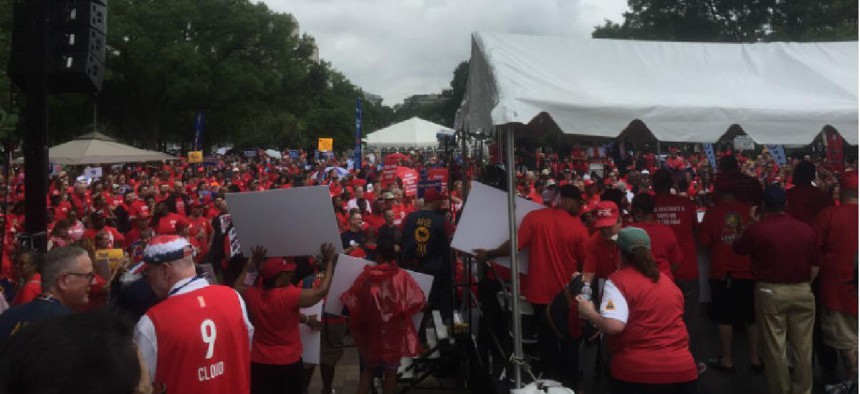What's in store for rank-and-file feds and managers in 2019?

A change in the political control of the House of Representatives could mean more leverage for federal unions and a focus on workforce policies that both sides of the aisle can support.

Unionized federal employees rally outside a Washington, D.C. courthouse on July 25. (Photo credit: Chase Gunter)
In his 2018 State of the Union speech, President Donald Trump said he wanted it to be easier to fire federal employees.
"I think it set the tone for the year," said Tony Reardon, president of the National Treasury Employees Union. "Federal employees really took notice."
Three executive orders issued in May and currently being contested in court left agencies emboldened to flaunt collective bargaining agreements, Reardon said. In the cases of the Departments of Veterans Affairs, Education and Health and Human Services, specifically, unions have challenged the agencies over various policy and collective bargaining issues.
"I think it probably goes without saying, but it was a pretty tough year for federal employees," Reardon said. "The administration has made it pretty clear, their disdain for the workforce."
There's evidence of declining morale in federal employee data. The Partnership for Public Service's annual Best Places to Work score dropped in 2018 after three straight years of improvement.
But things look a little different from the senior ranks. Bill Valdez, president of the Senior Executives Association (SEA), praised his members' relationship with the administration.
"We were determined from the beginning to engage in a constructive dialogue with the administration" and with conservative groups outside of government, like the Heritage Foundation, the Federalist Society and the Hoover Institute "to find common ground," he said. "And I think we've been successful."
Valdez specifically pointed to the modernization goals, emphases on bringing in high-demand cyber and tech talent and the President's Management Agenda, which "is based in part on recommendations that we made and that they listened to and heard."
Will 2019 be any different for federal employees?
Reardon is hoping the Democratic majority in the House of Representatives could help unions obtain a pay increase for federal workers, support collective bargaining with agencies and protect federal health and pension benefits.
On the administrative side, Reardon said that while he's recently spoken with acting Office of Personnel Management Director Margaret Weichert about working together, collaboration has so far been scarce.
"We certainly do have interaction with OPM on various things," he said. "But in terms of trying to work together and to spend a lot of time together to figure out how we can improve things for the federal workforce, I can't say there's been a great deal of interaction."
Valdez said he's looking specifically for legislative reform. SEA is rolling out a legislative proposal dubbed "10 Considerations" in early 2019. Valdez said SEA has already previewed the proposal with Weichert and is seeking support from lawmakers whose committee work involves oversight of the federal workforce, including Rep. Gerry Connolly (D-Va.) and Sen. James Lankford (R-Okla.).
"What the [plan] is all about is reskilling, retraining, making it easier to hire and retain people, holding people accountable, incentivizing good behavior, all the rest," said Valdez. "There's nothing in those 10 Considerations the unions themselves wouldn't buy into."
Valdez also said he's looking to fund public service leadership training for agency executives. In the Best Places to Work rankings, the area measuring "effective leadership" showed a precipitous drop.
Between SEA's plans and the President's Management Agenda, the modernization of the federal workforce "is probably a 10-year journey," Valdez said. "And if we don't start now, we could be in serious trouble."
In the meantime, the labor unions face ongoing litigation and are working through the collective bargaining process for workers' rights that need resolution.
"I will not ever close myself off to talking to folks from agencies, talking to the administration," Reardon said. "But I think the starting point has to be they are interested in building back trust with the federal workforce, with federal union representatives. And if that happens, then we might be able to do some good things together."
NEXT STORY: How to win at TMF





